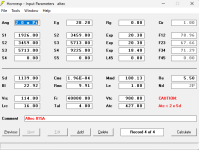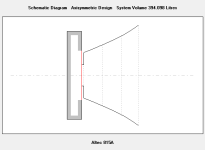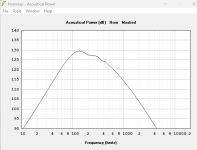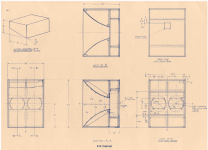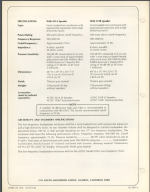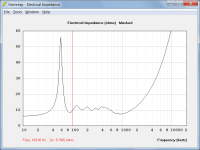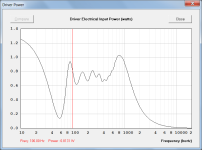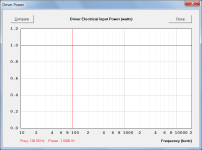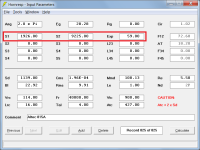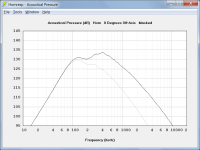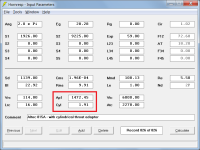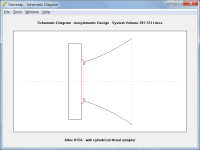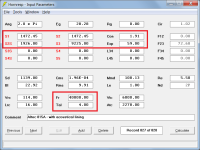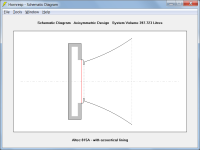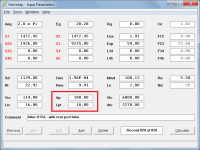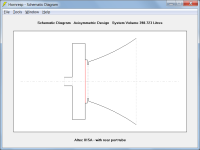Max spl does not use the standard hornresp power input field, but the max power as defined in the driver data (or the max power input window). I already tried to explain it to you here:Then go to maximum spl and simulating low power
https://www.diyaudio.com/community/threads/ajhorn-works-but-not-horn-response.411533/#post-7658188
Hi all, I'd appreciate some help modelling the Altec 815A enclosure with 2 x Altec 421 8H 15" drivers.
First Question: the cabinet is supposed to play from 100 - 1000Hz. Looks like my modelled response is dropping off well before 1000Hz. do we agree that there must be an error in what Ive input?
Second questions: I'm not sure if anyone can spot what I've got wrong here. One thing I'm a bit confused about is modelling in the throat hole for the driver. So I've made S1 the entire crossection of the start of the horn. Then I've input the area of the openings for the drivers in the "Atc" field and added the approx area of the hole for 1 driver. I assume it knows there are two such throat areas because I've selected 2 drivers.
Any tips appreciated.
Thanks.
Lachlan.
First Question: the cabinet is supposed to play from 100 - 1000Hz. Looks like my modelled response is dropping off well before 1000Hz. do we agree that there must be an error in what Ive input?
Second questions: I'm not sure if anyone can spot what I've got wrong here. One thing I'm a bit confused about is modelling in the throat hole for the driver. So I've made S1 the entire crossection of the start of the horn. Then I've input the area of the openings for the drivers in the "Atc" field and added the approx area of the hole for 1 driver. I assume it knows there are two such throat areas because I've selected 2 drivers.
Any tips appreciated.
Thanks.
Lachlan.
Attachments
When you simulate a response and then adjust it using the loudspeaker wizard, you see the acoustic power response. Then go to maximum spl and simulating low power, even just 1watt the response drastically changes.
The results are different for the two cases because the input powers are different.
Using the default record with chamber resonances masked as a test example:
Case 1 - Calculate button clicked. The input signal is a constant 2.83 volts. Although the input voltage is constant the input power is not, because of variations in the electrical input impedance.
Case 2 - Maximum SPL tool used. The input signal is a constant 1 watt.
Attachment 1 shows the variation in input impedance.
Attachment 2 shows the input power for Case 1.
Attachment 3 shows the input power for Case 2.
Attachments
Hi all, I'd appreciate some help modelling the Altec 815A enclosure with 2 x Altec 421 8H 15" drivers.
What you are looking at is the power response, which is the total output of the speaker over all directions. If you go to Tools -> Directivity -> Response, you can calculate the pressure frequency response in one particular direction, which is more similar to what what you would actually measure with a microphone at one position.
But note that can only be used for single segment horns, so you'll have to replace the 3-segment horn with a single exponential segment having the same entrance and exit areas.
Atc and Vtc are the total area and volume of the throat chamber, not per driver. In Hornresp, multiple drivers are treated as one driver with compound parameters (for instance, twice the Sd, twice the Mmd etc,, but you don't have to worry about that part). But that only applies to the driver itself, not any of the horn or enclosure geometry.
But really, in this case, Atc should be 2xSd, and Vtc should be the total volume in front of the cones (there's a tool to calculate the volume in front of one cone if you double click on the Vtc or Atc labels). And there should be a short straight segment in front of the horn to account for the driver mounting board. But that means you can't calculate the pressure frequency response.
But in the end, if you compare the various versions of Vtc/Atc, the differences are very small since the horn is essentially a 1:1 compression ratio design. Do the comparisons with approximate values, and see if the differences are worth the trouble of getting the model more accurate. And also consider that Hornresp can't take the fine details of the 3D geometry into account anyway.
Looks like my modelled response is dropping off well before 1000Hz. do we agree that there must be an error in what Ive input?
There is no error, it's just that the power response has been calculated, rather than the pressure response.
To calculate the pressure response, replace the three horn segments with a single Exp segment as shown in Attachment 1 then use the Directivity Response tool. Attachment 2 compares the power response (grey trace) to the on-axis pressure response (black trace).
One thing I'm a bit confused about is modelling in the throat hole for the driver.
The throat section can be more accurately modelled using a cylindrical throat adaptor as shown in Attachments 3 and 4, but then only the power response can be calculated.
Including the refinement makes very little difference to the results.
EDIT: I see that Bjørn just beat me to the punch
Attachments
Last edited:
Thank you so much for your guidance this was very helpfulWhat you are looking at is the power response, which is the total output of the speaker over all directions. If you go to Tools -> Directivity -> Response, you can calculate the pressure frequency response in one particular direction, which is more similar to what what you would actually measure with a microphone at one position.
But note that can only be used for single segment horns, so you'll have to replace the 3-segment horn with a single exponential segment having the same entrance and exit areas.
Atc and Vtc are the total area and volume of the throat chamber, not per driver. In Hornresp, multiple drivers are treated as one driver with compound parameters (for instance, twice the Sd, twice the Mmd etc,, but you don't have to worry about that part). But that only applies to the driver itself, not any of the horn or enclosure geometry.
But really, in this case, Atc should be 2xSd, and Vtc should be the total volume in front of the cones (there's a tool to calculate the volume in front of one cone if you double click on the Vtc or Atc labels). And there should be a short straight segment in front of the horn to account for the driver mounting board. But that means you can't calculate the pressure frequency response.
But in the end, if you compare the various versions of Vtc/Atc, the differences are very small since the horn is essentially a 1:1 compression ratio design. Do the comparisons with approximate values, and see if the differences are worth the trouble of getting the model more accurate. And also consider that Hornresp can't take the fine details of the 3D geometry into account anyway.
And there should be a short straight segment in front of the horn to account for the driver mounting board.
Using two stepped segments as suggested by Bjørn rather than one segment together with a cylindrical throat adaptor as suggested by me, has the advantage that it is then possible to also specify either acoustical lining material or a rear port tube if necessary, as shown in the attachments.
Attachments
- Home
- Loudspeakers
- Subwoofers
- Hornresp
